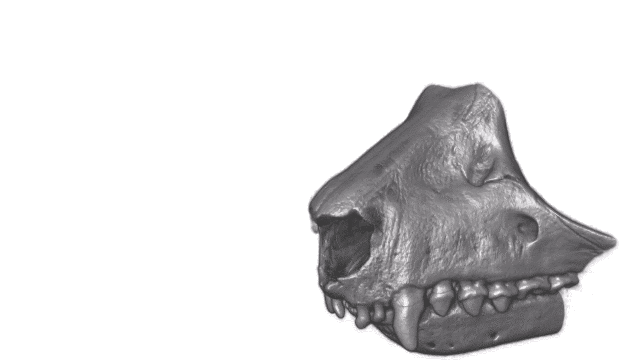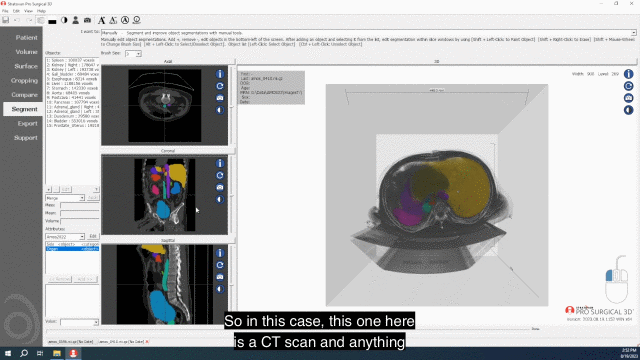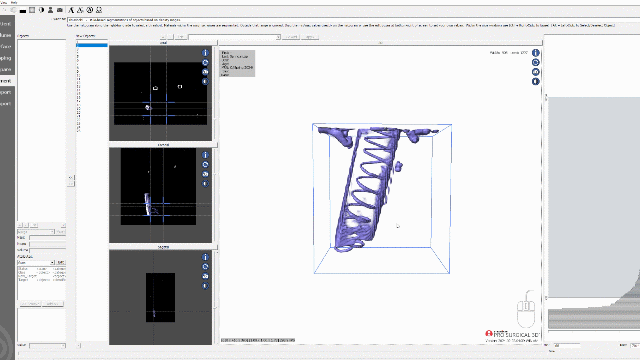Nestled in Northern California, Stratovan is a compact yet profoundly influential entity in the realms of 3D computer vision and image processing. Despite its modest team size of just 10 employees, Stratovan stands at the forefront of technological innovation, significantly impacting both the medical and aviation security industries. This small powerhouse is not just a participant in these fields but a trailblazer, developing solutions that have the potential to revolutionize how professionals in these areas operate.
Stratovan routinely hits well above its weight class with industry-wide adopted products like Checkpoint helping academic, research, and corporate projects alike with landmark placement and complex object analysis. Additionally, Stratovan's steadfast work on the DICOS file format standard alongside TSA, drawn from the DICOM standard in use in the medical industry, has proliferated globally to become the industry standard for image formats to enable open architecture and interconnectivity in the aviation security field. Time and again, Stratovan has taken an idea or an inspiration and applied decades of expertise to translate vision into reality with the power to disrupt an entire industry and empower opportunities for businesses, regulators, and customers alike.
Expertise in DICOS Image Format
One of Stratovan's primary areas of expertise is its profound command over the DICOS image format standard. As council members of the DICOS initiative working in conjunction with TSA, NEMA, and other industry partners, Stratovan's contributions have been crucial in crafting and maintaining this pivotal standard over the last decade. For industries reliant on precise and standardized image formats—particularly in aviation security—Stratovan’s leadership in developing the DICOS SDK positions it as an invaluable partner. The complexity of ensuring interoperability and maintaining high standards of data integrity across different imaging equipment is immense. While ensuring compliance and compatibility with existing equipment is critical, Stratovan also routinely advocated for, and championed, the inclusion of forward-looking protocols for additional equipment integration outside of current airport operations. The inclusion of future emerging technologies is a vital component of the value proposition of an open architecture environment so that data can be passed, shared, and secured for a better outcome for both airport security personnel and passengers alike. Stratovan’s role in the DICOS standard committee and as the software developer responsible for curating and supporting the DICOS Software Development Kit (SDK) these past years ensured that data from any DICOS-compliant device was reliable and universally usable, underscoring the importance of their expertise for potential partners who require robust and scalable imaging solutions. Stratovan remains the global expert in DICOS and is eager to assist with integration, testing, validation, and other DICOS related projects.
Innovations in Checkpoint and Segmentation Software
Stratovan has also made significant strides with its own product line, notably the Checkpoint software. This tool is essential for professionals who process 3D images, allowing for detailed analysis through functionalities such as landmark placement and measurement. Its versatility extends beyond typical usage scenarios, proving instrumental in scientific and forensic examinations. The ability to place landmarks, curves, and meshes accurately on 3D images allows users to perform precise measurements and detailed analysis of complex structures. In medical imaging, for example, Checkpoint can enable clinicians to measure anatomical features accurately or assess the progression of a disease by comparing changes in the structure over time. This level of precision can improve diagnostic accuracy and aid in treatment planning. Checkpoint’s ability to manipulate and analyze 3D images with such precision is also instrumental in research and development settings. In fields like biomechanics, these tools can help scientists and engineers simulate and analyze stress and strain on various materials or biological tissues, advancing our understanding of material properties and human biomechanics. The broad applicability of Checkpoint across different industries underscores its importance. Whether it's helping forensic experts reconstruct a crime scene in 3D, aiding architects in visualizing new builds, or enabling manufacturers to design better parts, the software offers a critical enhancement to traditional 3D imaging techniques.

Similarly, Stratovan's Segmentation for ProSurgical3D software is a pivotal tool for processing and analyzing data across various industries and scanners, significantly enhancing the preparation of data for AI and machine learning algorithm development. By enabling precise segmentation of complex 3D datasets—such as isolating a tumor from surrounding tissues in medical scans or identifying defects in manufactured components—the software ensures high-quality, accurate data input for AI models. This accuracy is critical in an industry like aviation security, where it can guide screening personnel to solid, liquid, or aerosol-based items that might be hazardous, or in manufacturing, where it ensures product safety and compliance. Additionally, the integrated automated QA tools guarantee that the segmented data meets stringent accuracy standards, making Stratovan's software indispensable for organizations aiming to leverage AI and machine learning for sophisticated, reliable solutions.

Leading the Open Platform Software Library (OPSL)
Stratovan's role as the system architect and primary developer of the Open Platform Software Library (OPSL) over the past seven years further illustrates its leadership and innovative capabilities in integrating technologies across complex environments like airport security. For the past seven years, Stratovan has spearheaded the development of OPSL, facilitating seamless connectivity between various devices used in airport checkpoints and luggage screening. Working in concert with TSA and the National Laboratories, Stratovan was able to bridge the proprietary divide between multiple incumbent vendors while providing an entry point for emerging technology and small third-party solution providers. Over the near decade of effort, this program flourished with multiple high-visibility demonstrations involving over a dozen vendor participants in a first-of-its-kind success. As OPSL continues to grow and evolve, Stratovan's effort to launch this project and prove the viability of open architecture approaches in the aviation security industry is allowing third-parties to being their specialized solutions to the market, allowing regulators, governments, and customers to choose best in class components and software for their needs. This initiative not only enhances security measures directly, but also optimizes the efficiency of operations across different checkpoints and different airports, making Stratovan a key player in global aviation security.
Advanced Detection Algorithms: ATR Capability
Perhaps the most critical capability that Stratovan offers is in the development of Automated Threat Detection (ATR) algorithms. These sophisticated algorithms are designed to identify a range of dangerous or prohibited items, from explosives and firearms to illegal drugs and endangered wildlife items. The versatility of Stratovan's ATR technology is such that it can be adapted to detect nearly any object of interest across a wide array of scanner vendors and data types. While Stratovan prides itself on its capability with 3D data, they also excel at working with 2D data and are equally qualified to work on or develop reconstruction algorithms. This flexibility makes Stratovan a highly desirable partner for organizations looking to enhance their security protocols or explore new areas of threat detection without the need to invest heavily in new technology.
The development of these algorithms involves deep learning techniques that require extensive training data to ensure accuracy and reliability. Additionally, Stratovan possesses its own innovative training architecture and robust compute clusters to enhance the speed and security of any solutions it develops in-house. The overall challenge facing algorithm development is not just technical but also logistical, as collecting and processing the right data is critical to the success of these algorithms. Stratovan's expertise not only in algorithm development but also in handling complex datasets makes it an ideal partner for enterprises aiming to leverage advanced detection technologies. Whether working on government contracts for TSA or DHS, or partnering with other businesses, Stratovan has performed multiple data collection efforts across a wide variety of devices and in different locations. Developing data collection plans, and executing proper collection procedures is vital to establish the appropriate combination of training and testing data sets to ensure performance can be properly gauged and tuned to meet performance requirements in the fields. Additionally, Stratovan is able to categorize and work with large amounts of data easily. Stratovan's Segmentation software, mentioned above, provides the perfect toolset to ground truth the data and to inspect and correct any issues before the data is used in training. Once these major steps are done, training an ATR becomes one part scientific endeavor, and one part work of art, as the team works diligently to train multiple models across multiple folds to find the perfect blend of variables to maximize positive detection while driving down false alarm rates.
Stratovan is a global expert in detection algorithm development, and we would love to show you why.

Questions? Come Ask the Experts...
Stratovan's ability to deliver cutting-edge solutions in 3D imaging and object detection is unmatched in the industry. For potential partners, working with Stratovan means access to top-tier technological advancements, deep domain expertise, and a proven track record of impactful innovations. Whether in medical imaging, aviation security, or any field that requires sophisticated image processing and object detection, Stratovan is equipped to lead the way. The company's ongoing commitment to innovation and its role in developing industry standards and technologies invite collaboration with partners eager to push the boundaries of what is possible in their respective fields. Interested parties are encouraged to reach out to explore how Stratovan's capabilities can be integrated into their operations for enhanced outcomes and technological advancements. Let's save lives through software....together.